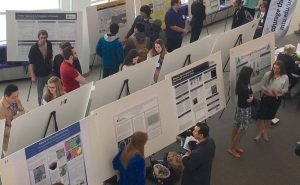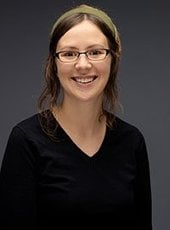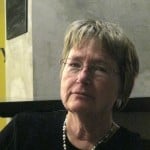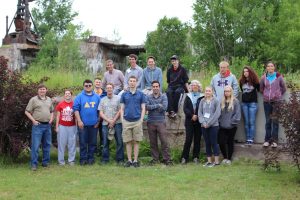 Chelsea Schelly (SS), Joshua Pearce (MSE/ECE) and Emily Prehoda, a PhD student in Social Sciences, have recently published “U.S. Strategic Solar Photovoltaic-powered Microgrid Deployment for Enhanced National Security.”
Chelsea Schelly (SS), Joshua Pearce (MSE/ECE) and Emily Prehoda, a PhD student in Social Sciences, have recently published “U.S. Strategic Solar Photovoltaic-powered Microgrid Deployment for Enhanced National Security.”

Richelle Winkler co-authored a research brief, Moving to Diversity, with Kenneth Johnson from the University of New Hamphire. Using new data and techniques, they find that net migration between counties increased racial diversity in each of the last two decades. The full report can be found here: https://carsey.unh.edu/publication/moving-diversity.
 Joe Iwanicki – Anthropology – Social Sciences
Joe Iwanicki – Anthropology – Social Sciences
Iwanicki’s research, The Archaeology of Trade: A Study of a Twentieth Century Logging Camp, was presented at Michigan Tech’s 2017 Undergraduate Research Symposium this past week. With the assistance of LouAnn Wurst, Iwanicki looked at archaeological data from a 1900’s lumber camp in the Munising Michigan area called Coalwood. The data consists of artifacts that allow for investigation of trade and commodity flows. The archaeological record is combined with GIS to map and recreate the trade networks of the past, something rarely explored by archaeologists.
The Undergraduate Research Symposium highlights the amazing cutting-edge research being conducted on Michigan Tech’s campus by some of our best and brightest undergraduate students.
The students showcasing their work today have spent a significant portion of the past year working alongside Michigan Tech faculty and graduate students to explore, discover and create new knowledge. They’ve spent long hours in the lab or out in the field designing experiments, gathering data, creating new models and testing hypotheses. They’ve applied their classroom knowledge in new and sometimes unexpected ways, and developed new skills that will propel them forward in their careers.

Chelsea Schelly was quoted in the Sierra Magazine article Think Your Household Is Susatinable? Think Again. Schelly is a co- principal investigator on the project, “Reducing Household Food, Energy and Water Consumption: A Quantitative Analysis of Interventions and Impacts of Conservation.”, that has received a $1,477,068 grant from the National Science Foundation.
 From The Keweenaw Report
From The Keweenaw Report
The Villages of Calumet and Laurium and Calumet Township all have highlights and their own challenges.
Dwindling populations and median household incomes well below the state average–especially in Calumet Village–have reduced the availability of services to residents over the years.
A team from Michigan Tech’s Department of Social Sciences has spent the last four months looking at the advantages and disadvantages of several options for the area.
Doctoral Student Kelley Christensen said, “We looked at five different possibilities. We looked at keeping the status quo, we looked at intergovernmental agreements, revenue sharing, the possibility of the Village of Calumet dissolving into the township, and we also looked at the possibility of Laurium and Calumet Village becoming a city.”
Changes could take years to implement and a monumental effort would be needed by all community members involved, but Christensen says it all starts with people willing to talk about the possibilities.
Christensen said, “We just really hope that this starts a conversation. Our purpose here was to provide information to them and give them a list of options, and then we’re hoping that it will facilitate discussion and participation in government.”
Their report is online for the public to review.
http://www.mtu.edu/social-sciences/research/reports/
The team will also post the power point presentation from Monday’s meeting online. Questions can be directed to Dr. Richelle Winkler of Michigan Tech’s Department of Social Sciences.
 John Baeten, IHA PhD Candidate, recently had a post published by NiCHE (Network in Canadian History and Environment) for their “Seeds: New Research in Environmental History” Series, titled: “Busting Ghosts: Building an HGIS to Reveal Historical Mine Waste Producers and Develop Strategies to Mitigate Future Risk”
John Baeten, IHA PhD Candidate, recently had a post published by NiCHE (Network in Canadian History and Environment) for their “Seeds: New Research in Environmental History” Series, titled: “Busting Ghosts: Building an HGIS to Reveal Historical Mine Waste Producers and Develop Strategies to Mitigate Future Risk”
J ohn Baeten, Nancy Langston, and Don Lafreniere recently published an article titled: “A Geospatial Approach to Uncovering the Hidden Waste Footprint of Lake Superior’s Mesabi Iron Range” published in The Extractive Industries and Society.
ohn Baeten, Nancy Langston, and Don Lafreniere recently published an article titled: “A Geospatial Approach to Uncovering the Hidden Waste Footprint of Lake Superior’s Mesabi Iron Range” published in The Extractive Industries and Society.
The article is available for download until January 26, 2017 at the following link: https://authors.elsevier.com/a/1UAjI,oMyQ5uEu
Article Abstract: “For decades, the Lake Superior Iron District produced a significant majority of the world’s iron used in steel production. Chief among these was the Mesabi Range of northern Minnesota, a vast deposit of hematite and magnetic taconite ores stretching for over 100 miles in length. Iron ore mining in the Mesabi Range involved three major phases: direct shipping ores (1893–1970s), washable ores (1907– 1980s), and taconite (1947–current). Each phase of iron mining used different technologies to extract and process ore. Producing all of this iron yielded a vast landscape of mine waste. This paper uses a historical GIS to illuminate the spatial extent of mining across the Lake Superior Iron District, to locate where low- grade ore processing took place, and to identify how and where waste was produced. Our analysis shows that the technological shift to low-grade ore mining placed new demands on the environment, primarily around processing plants. Direct shipping ore mines produced less mine waste than low-grade ore mines, and this waste was confined to the immediate vicinity of mines themselves. Low-grade ore processing, in contrast, created more dispersed waste landscapes as tailings mobilized from the mines themselves into waterbodies and human communities.”
 Audrey Mayer and Ashma Vaidya, who recently completed her PhD degree requirements in environmental and energy policy, published an article “Critical Review of the Millennium Project in Nepal” in Sustainability 2016, 8(10), 1043; doi:10.3390/su8101043
Audrey Mayer and Ashma Vaidya, who recently completed her PhD degree requirements in environmental and energy policy, published an article “Critical Review of the Millennium Project in Nepal” in Sustainability 2016, 8(10), 1043; doi:10.3390/su8101043
 Mary Durfee (SS), participated in the Polar Law Symposium and Arctic Circle held in Akureyri and Reykjavik, Iceland, October 5-9, 2016. She gave a paper, “Free Trade: The Expected Impacts of TTIP and CETA on the Arctic” and chaired a panel devoted to Sovereignty and Its Contestation at the Poles.
Mary Durfee (SS), participated in the Polar Law Symposium and Arctic Circle held in Akureyri and Reykjavik, Iceland, October 5-9, 2016. She gave a paper, “Free Trade: The Expected Impacts of TTIP and CETA on the Arctic” and chaired a panel devoted to Sovereignty and Its Contestation at the Poles.
 Keweenaw Time Traveler and National Park Service received media attention for their NSF-ITEST GRACE Project collaboration in Directions Magazine, a national GIS periodical. The article, G.R.A.C.E Project team creates ‘time machine’ with GIS, outlines some of the detail of the summer career education program that brought local high school students to work with the KHNP and the Keweenaw Time Traveler team as paid interns.
Keweenaw Time Traveler and National Park Service received media attention for their NSF-ITEST GRACE Project collaboration in Directions Magazine, a national GIS periodical. The article, G.R.A.C.E Project team creates ‘time machine’ with GIS, outlines some of the detail of the summer career education program that brought local high school students to work with the KHNP and the Keweenaw Time Traveler team as paid interns.